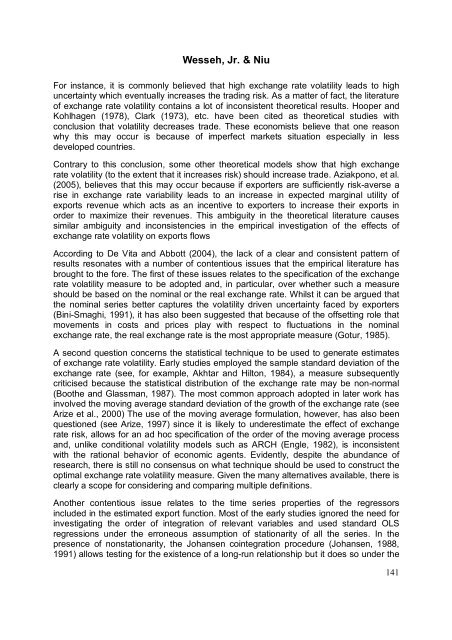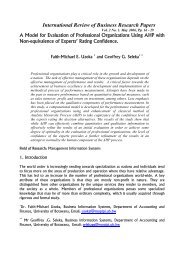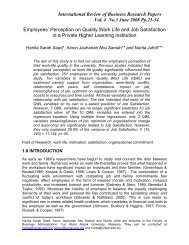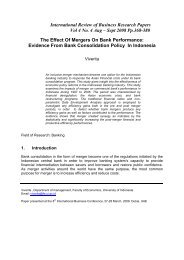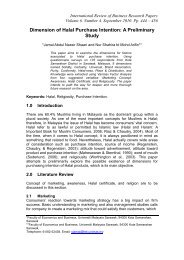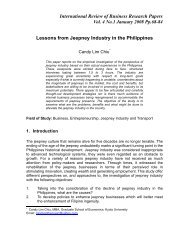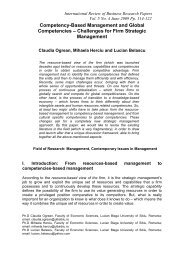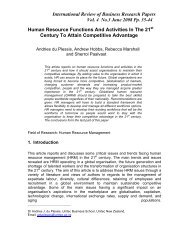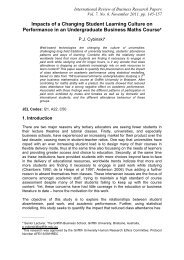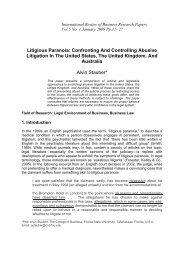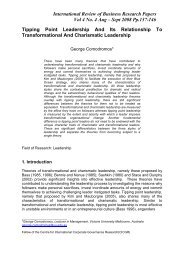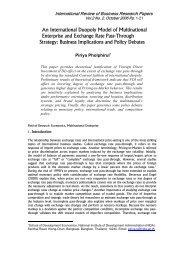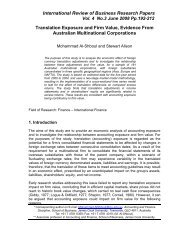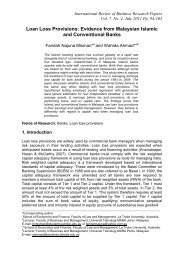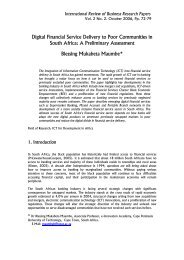The Impact of Exchange Rate Volatility on Trade Flows: New ...
The Impact of Exchange Rate Volatility on Trade Flows: New ...
The Impact of Exchange Rate Volatility on Trade Flows: New ...
You also want an ePaper? Increase the reach of your titles
YUMPU automatically turns print PDFs into web optimized ePapers that Google loves.
Wesseh, Jr. & NiuFor instance, it is comm<strong>on</strong>ly believed that high exchange rate volatility leads to highuncertainty which eventually increases the trading risk. As a matter <str<strong>on</strong>g>of</str<strong>on</strong>g> fact, the literature<str<strong>on</strong>g>of</str<strong>on</strong>g> exchange rate volatility c<strong>on</strong>tains a lot <str<strong>on</strong>g>of</str<strong>on</strong>g> inc<strong>on</strong>sistent theoretical results. Hooper andKohlhagen (1978), Clark (1973), etc. have been cited as theoretical studies withc<strong>on</strong>clusi<strong>on</strong> that volatility decreases trade. <str<strong>on</strong>g>The</str<strong>on</strong>g>se ec<strong>on</strong>omists believe that <strong>on</strong>e reas<strong>on</strong>why this may occur is because <str<strong>on</strong>g>of</str<strong>on</strong>g> imperfect markets situati<strong>on</strong> especially in lessdeveloped countries.C<strong>on</strong>trary to this c<strong>on</strong>clusi<strong>on</strong>, some other theoretical models show that high exchangerate volatility (to the extent that it increases risk) should increase trade. Aziakp<strong>on</strong>o, et al.(2005), believes that this may occur because if exporters are sufficiently risk-averse arise in exchange rate variability leads to an increase in expected marginal utility <str<strong>on</strong>g>of</str<strong>on</strong>g>exports revenue which acts as an incentive to exporters to increase their exports inorder to maximize their revenues. This ambiguity in the theoretical literature causessimilar ambiguity and inc<strong>on</strong>sistencies in the empirical investigati<strong>on</strong> <str<strong>on</strong>g>of</str<strong>on</strong>g> the effects <str<strong>on</strong>g>of</str<strong>on</strong>g>exchange rate volatility <strong>on</strong> exports flowsAccording to De Vita and Abbott (2004), the lack <str<strong>on</strong>g>of</str<strong>on</strong>g> a clear and c<strong>on</strong>sistent pattern <str<strong>on</strong>g>of</str<strong>on</strong>g>results res<strong>on</strong>ates with a number <str<strong>on</strong>g>of</str<strong>on</strong>g> c<strong>on</strong>tentious issues that the empirical literature hasbrought to the fore. <str<strong>on</strong>g>The</str<strong>on</strong>g> first <str<strong>on</strong>g>of</str<strong>on</strong>g> these issues relates to the specificati<strong>on</strong> <str<strong>on</strong>g>of</str<strong>on</strong>g> the exchangerate volatility measure to be adopted and, in particular, over whether such a measureshould be based <strong>on</strong> the nominal or the real exchange rate. Whilst it can be argued thatthe nominal series better captures the volatility driven uncertainty faced by exporters(Bini-Smaghi, 1991), it has also been suggested that because <str<strong>on</strong>g>of</str<strong>on</strong>g> the <str<strong>on</strong>g>of</str<strong>on</strong>g>fsetting role thatmovements in costs and prices play with respect to fluctuati<strong>on</strong>s in the nominalexchange rate, the real exchange rate is the most appropriate measure (Gotur, 1985).A sec<strong>on</strong>d questi<strong>on</strong> c<strong>on</strong>cerns the statistical technique to be used to generate estimates<str<strong>on</strong>g>of</str<strong>on</strong>g> exchange rate volatility. Early studies employed the sample standard deviati<strong>on</strong> <str<strong>on</strong>g>of</str<strong>on</strong>g> theexchange rate (see, for example, Akhtar and Hilt<strong>on</strong>, 1984), a measure subsequentlycriticised because the statistical distributi<strong>on</strong> <str<strong>on</strong>g>of</str<strong>on</strong>g> the exchange rate may be n<strong>on</strong>-normal(Boothe and Glassman, 1987). <str<strong>on</strong>g>The</str<strong>on</strong>g> most comm<strong>on</strong> approach adopted in later work hasinvolved the moving average standard deviati<strong>on</strong> <str<strong>on</strong>g>of</str<strong>on</strong>g> the growth <str<strong>on</strong>g>of</str<strong>on</strong>g> the exchange rate (seeArize et al., 2000) <str<strong>on</strong>g>The</str<strong>on</strong>g> use <str<strong>on</strong>g>of</str<strong>on</strong>g> the moving average formulati<strong>on</strong>, however, has also beenquesti<strong>on</strong>ed (see Arize, 1997) since it is likely to underestimate the effect <str<strong>on</strong>g>of</str<strong>on</strong>g> exchangerate risk, allows for an ad hoc specificati<strong>on</strong> <str<strong>on</strong>g>of</str<strong>on</strong>g> the order <str<strong>on</strong>g>of</str<strong>on</strong>g> the moving average processand, unlike c<strong>on</strong>diti<strong>on</strong>al volatility models such as ARCH (Engle, 1982), is inc<strong>on</strong>sistentwith the rati<strong>on</strong>al behavior <str<strong>on</strong>g>of</str<strong>on</strong>g> ec<strong>on</strong>omic agents. Evidently, despite the abundance <str<strong>on</strong>g>of</str<strong>on</strong>g>research, there is still no c<strong>on</strong>sensus <strong>on</strong> what technique should be used to c<strong>on</strong>struct theoptimal exchange rate volatility measure. Given the many alternatives available, there isclearly a scope for c<strong>on</strong>sidering and comparing multiple definiti<strong>on</strong>s.Another c<strong>on</strong>tentious issue relates to the time series properties <str<strong>on</strong>g>of</str<strong>on</strong>g> the regressorsincluded in the estimated export functi<strong>on</strong>. Most <str<strong>on</strong>g>of</str<strong>on</strong>g> the early studies ignored the need forinvestigating the order <str<strong>on</strong>g>of</str<strong>on</strong>g> integrati<strong>on</strong> <str<strong>on</strong>g>of</str<strong>on</strong>g> relevant variables and used standard OLSregressi<strong>on</strong>s under the err<strong>on</strong>eous assumpti<strong>on</strong> <str<strong>on</strong>g>of</str<strong>on</strong>g> stati<strong>on</strong>arity <str<strong>on</strong>g>of</str<strong>on</strong>g> all the series. In thepresence <str<strong>on</strong>g>of</str<strong>on</strong>g> n<strong>on</strong>stati<strong>on</strong>arity, the Johansen cointegrati<strong>on</strong> procedure (Johansen, 1988,1991) allows testing for the existence <str<strong>on</strong>g>of</str<strong>on</strong>g> a l<strong>on</strong>g-run relati<strong>on</strong>ship but it does so under the141


